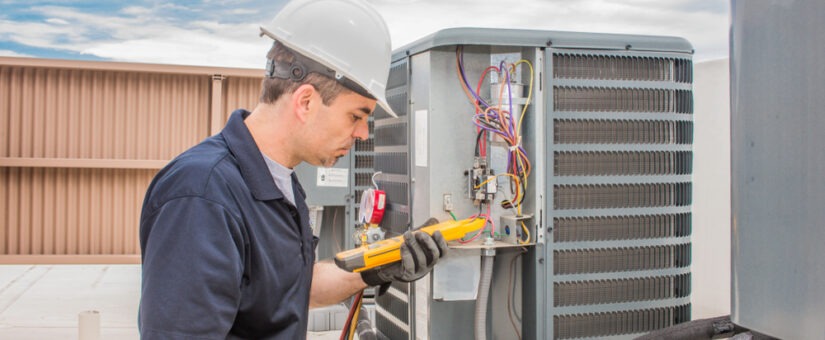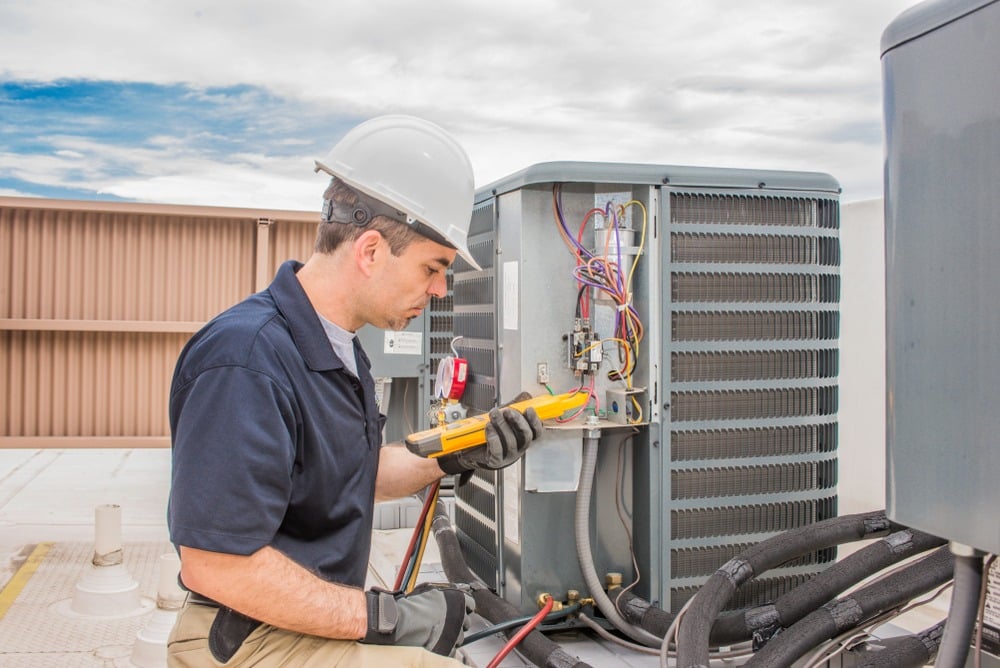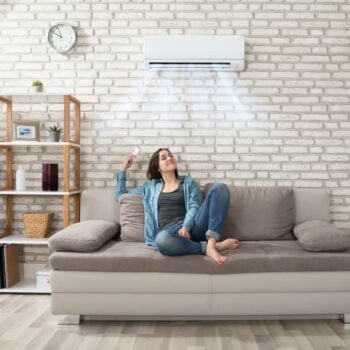
- On June 4, 2020
Air Conditioner Maintenance – The Ultimate Homeowners Guide 2021

What You’ll Learn
As you read this complete guide to air conditioner maintenance, you’ll learn:
- The benefits of regular air conditioning maintenance far outweigh the costs because tune-ups keep your home more comfortable and save you money in the long run.
- There are a few DIY A/C maintenance things that just about everyone can handle, and it all starts with understanding your HVAC system.
- More involved air conditioner maintenance will still require an HVAC contractor or your local A/C repair company.
Why Is Air Conditioning Maintenance Important?
When you live in Phoenix, we really don’t have to explain to you why your air conditioner is so important. In fact, this city couldn’t possibly be what it is today without air conditioning. Life in the desert can be extremely challenging, and air conditioning makes it much easier to survive and thrive even when the weather outside is oppressively hot.
Air conditioning units first became widely available in the 1950s thanks to prosperity in the United States after World War II. As the prevalence of air conditioners started to rise, so did the population of Phoenix. It’s no coincidence that Phoenix has gone from being the 99th most populated city in the country to the 5th since air conditioning was invented.
Because air conditioning makes life a lot more pleasant here in the Valley of the Sun, it’s important to make sure you’re taking care of your system. If you let your system get so out of shape that it fails completely, your home might get miserably hot within a matter of hours. Keeping your home comfortable is one of the top benefits of A/C maintenance, but it’s far from the only one.
Air conditioner tune-ups, regular DIY maintenance, and other effective services will help produce the following advantages:
- Make your air conditioner last longer.
- Save money in the long run by preventing expensive repairs.
- Make your air conditioner operate more efficiently to reduce the cost of utility bills.
- Improve the air quality in your home.
- Achieve a more comfortable home by keeping the temperatures more consistent throughout every room.
To achieve all of these benefits, it’s important to develop a strategy for air conditioner maintenance.
Best A/C Maintenance Strategies
You don’t have to become an HVAC contractor to learn a thing or two about getting the most out of your equipment. In fact, everyone can develop a successful maintenance strategy, largely because it’s so easy to get help from dedicated professionals. When you want to create a plan that will help you keep your air conditioner in great shape, save you some money, and make your system last longer, it generally comes down to three simple steps.
- Learn some of the basics about your system. Most importantly, learn about common air conditioner problems and how to solve them.
- Next, learn about some simple DIY air conditioner maintenance tips. This will help you know what to check before you call for air A/C repair.
- Finally, learn how to recognize when it’s time to call for help. It’s advisable to keep standing appointments for A/C tune-ups, and learning how to diagnose common problems will also help you know when to call for help proactively.
As you start planning your A/C tune-up and service strategy, you may notice that learning how to diagnose common issues is perhaps the most important part of the equation.
Common Air Conditioner Problems
Recognizing that there is a problem is the first step toward solving it. Knowing a thing or two about some of the most common air conditioning issues will also make them less intimidating. Many people put off air conditioning maintenance and repair simply because they don’t know what to expect, which makes the process scary to them. Learn a little bit more about the following problems, and you’ll be prepared for whatever your HVAC system throws your way.
Poor A/C Airflow
HVAC airflow problems can be extremely frustrating. The A/C unit is operating, but none of that cold air is actually reaching your rooms, which is the whole point. Understandably, you’ll want to figure out what’s wrong and get it taken care of as soon as possible. We can normally attribute air conditioning airflow problems to one of the following causes:
Blocked or Damaged Ducts
The ductwork that runs throughout the building is responsible for delivering treated air to all rooms. If this ductwork becomes damaged and develops a leak, all of your cool air can leak out into the walls. It’s also possible that your ductwork has become stopped up with dirt, dust, or something else that prevents air from coming through as it should.
Clogged or Dirty Filters
The filter exists to keep contaminants like dirt and dust from getting into your ductwork. This is an important job, but it also means the filters themselves are catching all of those things. Eventually, they may get so dirty that they can’t let air through anymore. Luckily, changing the filter is one of the easiest things you can do by yourself to restore airflow.
Covered Vents or Dampers
If you notice that poor airflow only makes one of your rooms especially uncomfortable, this might be the cause. Sometimes vents or dampers get stuck in the closed position and prevent air from coming out. Additionally, make sure you aren’t blocking any of the vents with things like rugs, furniture, or anything else.
Wrong Ductwork
Your ductwork and your HVAC unit itself have to be compatible. If your ductwork is too big and cavernous, your air conditioner will have a hard time pumping out enough air to fill the ductwork in a way that gets cool air to the rooms. On the other hand, if your ductwork is undersized, it can’t accommodate all of the air. Unless you’ve had new ductwork installed recently, compatibility shouldn’t be the problem.
Obstructed Condenser Coils
The condenser coil is the component that transfers the heat collected inside your home back to the outside. If it’s too dirty to release temperature the way it should, your system can’t complete the heat transfer effectively, which leads to airflow problems inside. If this is a problem at your home, pay special attention to the section on maintaining the outdoor unit under DIY air conditioning maintenance below.
Bad Air Conditioner Thermostat
Thermostat problems are something of good news, bad news situation. The good news is that this may be a simple fix if your thermostat has just landed on the wrong setting (perhaps because someone else in the house has been fiddling with it… again). If the thermostat is set correctly and still isn’t working, the problem is likely more serious. It could be that it’s having a hard time telling what the temperature is in your home, or maybe the thermostat cannot get a signal to the rest of the system anymore.
Electrical Problems With Air Conditioner
There’s a lot of great technology in modern HVAC systems. Unfortunately, this means that there are plenty of opportunities for electrical problems. All of the different electrical components are connected with wiring that transfers power and signals throughout the system. If any part of this wiring fails, it can derail the entire system. You might be able to deduce that there’s an electrical problem if you notice your A/C tripping the breaker or simply refusing to turn on.
Low Refrigerant in Air Conditioner
Refrigerant is the special chemical that makes your air conditioner work, so there will be problems if the levels get too low. Refrigerant can also be toxic enough to cause problems if too much of it leaks out in too short an amount of time. If your refrigerant gets low, it probably means your system has sprung a leak. You can diagnose this problem by identifying any of the following:
- Hissing or bubbling noise
- Frozen A/C or refrigerant lines
- Air conditioner blowing warm air
- Rising energy bills
Air Conditioner Making Banging Noises
If you hear a loud banging noise coming from the air conditioner, it’s probably a compressor problem. A/C rattling noises or banging happen because a part has come loose. As the air conditioner does its job, the loose part slaps against other parts or the unit’s body and makes these noises. It’s a good idea to turn your system off before the loose part knocks any others loose, then schedule emergency service.
Air Conditioner Screeching
If you hear your air conditioning unit shriek while it works, it could point to one of a few different things:
- Broken compressor motor
- Broken blower fan motor
- Failed bearings in the fan motor
Motor problems are serious, so again, it’s a good idea to turn the system off until you can get it repaired.
Broken Condensate Airflow Switch
Also known as the float switch, this is responsible for ensuring the unit turns off when the drain pan gets full of water. There are a few signs you can look for that will tell you if the switch has failed. The first sign is that your air conditioner runs continuously. The next sign is that there is algae, mildew, or a moldy smell in your air conditioner. Finally, any leaking could be a sign of condensate airflow switch problems.
Air Conditioner Drain Clogged
This is such a common problem that new units actually include sensors to detect when the drain is clogged. Unfortunately, older units won’t give you any warning until the problem gets severe enough to impact performance. Either way, it’s a good idea to give the drain pan a look every time you replace the filter in your air conditioner. If you see water backing up, you may be able to get the clog out yourself, but don’t try anything you’re not confident about. You don’t want to make the problem worse by damaging the system while trying to fix it.
Air Conditioner Freezing
Your air conditioner should be able to get nice and cold to keep your home comfortable on those scorching days here in Maricopa County, but it shouldn’t be freezing. Take a look at your unit to see if the refrigerant lines or any other part of your system has frozen. The first step, in this case, is always to turn the system off until it can thaw out.
Many of the problems that lead to air conditioner freezing require professional service, but the good news is that you may be able to fix it just by replacing the dirty filter. The first step here is to learn about common DIY maintenance, so you know what the options are.
DIY Air Conditioning Maintenance
Unless you’re an electrician or an HVAC contractor, there will always be times you need to call a professional for A/C maintenance. The good news, though, is that there are things you can do by yourself. You’ll save a little bit of money by performing some of the maintenance, and the professional service you do receive will be less of a mystery to you. The first step is to understand how your air conditioner works.
Know Your Unit
Gauge the complexity of your specific unit. Older units are more straightforward, which makes them simpler to understand and maintain. Of course, older units have also been subjected to more wear and tear, so they’re likely to have more serious problems. New units can be complicated because they include so much more modern technology.
Ignoring some of the more complicated sensors and technology for now, here’s a general look at how your air conditioner works:
- Inside your home, the evaporator exposes the refrigerant to the warm air in your home, which causes the refrigerant to build energy and collect a lot of temperature. At this stage, the refrigerant is sucking up heat from your home.
- The hot, compressed refrigerant gas is moved by the compressor from the inside of your home to the condenser outside. With the help of metal fins, the condenser releases all of the heat from the refrigerant into the air outside your home.
- As the refrigerant releases heat, it transitions back from a pressurized gas to a fluid. It also becomes cool once again.
- The cool refrigerant travels back into your home, and the fan inside of your indoor A/C unit blows over it to push cool air throughout the home.
- At this point, the process begins again.
This is a very simplified version of the process. Still, it should give you some basic understanding of how your air conditioner works. Understanding these basics is a great first step that will help you diagnose and maintain your air conditioner.
Maintain the Outdoor A/C Unit
Recall from your reading on the common air conditioning problems that many of them originate in the outdoor unit. Problems in the portion of your air conditioning system outside the home could be why you have poor airflow or an air conditioner blowing warm air. Luckily, there are multiple DIY steps you can follow to help keep your outdoor A/C unit in good shape:
- Before you do anything to the outdoor unit, turn your air conditioning system off. You can do this by turning the A/C off through the thermostat or by using the switch on the unit itself.
- Remove any plants or debris that has gotten onto or into the unit. Avoid storing things too close to the unit, and it’s generally best to leave at least two feet of space around the unit on all sides.
- Check the fins inside of the outdoor unit. If they’re dirty, you can clean them by hosing them off gently. Just make sure you don’t spray them hard enough that you bend them. If your fins are already bent, they will have to be straightened.
- While you’re cleaning the outside component of the air conditioner, especially when you’re using the hose, make sure you don’t get moisture down into the motor. The system is designed to be outside so that it can stand up to some water, but it’s still a good idea to make sure you don’t spray any in at an angle where it can reach the motor.
- Clean the condenser fan. Remember that dirty condensers can cause a lot of problems, and it needs to be clean to do its job. You can remove leaves, dust, and other debris before gently wiping it with a damp cloth.
Once you’ve completed everything you had to do to your outdoor unit and put it back how it was (if you took the sides off for cleaning), you can turn it back on.
Mind the Airflow
There are two DIY things you can do all by yourself to make sure the airflow of your HVAC system stays good. First, take good care of the vents. Maintaining the ductwork itself is a bit more complicated, especially if you don’t have the right tools and equipment, but at least you can access the areas where the ductwork comes into your rooms. Keep the vents clear from furniture, and periodically check them to ensure they’re open and free from dust. If your vents are always getting dusty, you may have dirty ducts that need professional cleaning.
Next, take good care of the air filters. Changing the filter is one of the easiest things you can do by yourself for your home, but many people still forget to keep up with this critical piece of maintenance. If your air filter gets too dirty, it will eventually restrict airflow and cause other problems like A/C freezing. Generally, it’s a good idea to change this filter every 90 days, and certainly every six months at the very minimum. If you have many people or pets living in your home, or if you have allergies, plan on changing the filter as often as every month.
Take Care of the Indoor A/C Unit
Beyond changing the air filter, you can do a few other things to take care of the indoor portion of your air conditioner. This unit houses the evaporator, which provides cool refrigerant, and it also holds the blower, which pushes the cool air throughout the ductwork and into your home. If either the evaporator or the blower is struggling, you’ll notice immediate problems throughout the home.
Unfortunately, caring for these particular components isn’t nearly as easy as changing the air filter. Still, it’s important that you either learn how to do it yourself or have a professional perform an A/C tune-up regularly. If you’re comfortable with it, you might try cleaning the dust and dirt off of your evaporator coil using a no-rinse coil cleaner. It’s also fairly easy to check the evaporator drain for clogs, debris, and backups. As always, turn your system off completely before you start removing any parts or sticking your hands inside of it.
Give Your Air Conditioner a Break
This is the single easiest thing you can do for your air conditioner to help it stay in good health (even easier than changing the filter)! The weather in Phoenix puts a lot of strain on your system, and just like with humans, too much stress can shorten the life of your air conditioner. Take some of the burden off by getting in the habit of showing your A/C some love from time to time.
There are multiple easy ways to reduce the stress on your air conditioner:
- Raise the temperature by a few degrees on hot days, so your unit doesn’t have to work as hard.
- Keep the blinds and curtains closed to block sunlight and reduce the heat in your home.
- Turn the fan on when you enter a room, so you don’t need the A/C as much.
- Turn the thermostat up when you leave the house for long periods of time.
These practices make your A/C last longer. As an added bonus, they also decrease your carbon footprint and lower your utility bills. Keep in mind that great air conditioning habits can supplement the work professionals do in your home but not eliminate the need for professional HVAC service.
Professional A/C Maintenance
All of the above steps will help your air conditioner last longer and function better. There will still be some things you just can’t address by yourself, though. That’s completely ok, and it doesn’t mean you aren’t a good homeowner!
All it means is that the professionals have specialized equipment and years of training that you don’t. Modern air conditioners are complex pieces of equipment. It takes a professional to keep everything running smoothly, and sticking with a good maintenance plan will work wonders for your HVAC system.
Preventative Air Conditioning Maintenance
The single best thing you can do for your air conditioner is connect with a trustworthy HVAC company in Phoenix and sign up for a regular maintenance schedule. They’ll come out at regular intervals, carefully check everything, then calibrate your equipment to ensure optimal health and performance. They’ll confirm that your equipment is ready for the coming seasons, and this is also an opportunity to fix small problems before they grow into big problems.
Air Conditioner Repair
When you get an A/C tune-up, it might expose a need for repairs. This is a good thing, though, because if you wait too long or don’t get inspections, you’ll end up needing much more significant, expensive repairs. Every air conditioner will need at least some minor repairs during the course of its life. This is just a normal part of having a complicated piece of machinery and using it heavily for many years.
Some of the most common types of air conditioning repairs you may need to maintain the health of your system include the following:
- Electrical Problems – If you don’t have specialized training and the proper equipment, you’ll have to have a professional handle these types of complications.
- Short Cycling – Almost any time your air conditioner starts turning off a lot in a short amount of time, you have problems that require professional attention. You can try checking the filter to see if it’s dirty or clogged first. If the filter looks good, it’s time to call for backup to inspect the other potential issues.
- Ductwork – Beyond peering into the ductwork just inside of your vents, you’ll need a professional to address damaged or blocked ducts.
- Low Refrigerant – It takes a professional to fix leaks then replenish the refrigerant.
- Failed Components – When it comes to repairing or replacing any component of your air conditioner more involved than the filter, from the blower motor to the compressor or anything in between, you’ll need a professional to find the right parts and do the job correctly.
Repair or Replace Air Conditioner?
The whole point of keeping up with regular A/C maintenance is that you can avoid this dilemma for as long as possible. At some point, though, you’ll eventually have to decide if it’s worth keeping up with the maintenance of your system or if you’re better off getting a new one. A professional can help you here, too. Call a trusted HVAC company in the Phoenix area, and have them give you an honest, professional opinion about all of your options.
Air Conditioner Maintenance in Maricopa County
If you made it all the way through the guide, congratulations, you’ve just learned a lot about the basics of A/C maintenance.
Now you’re ready to keep an eye out for problems and even perform some light DIY air conditioning maintenance by yourself. For everything else, you can count on Howard Air. We’ve been serving the Phoenix area since 1977, and we know what it takes to keep your air conditioner in great shape!
Call us anytime at 480-508-9866 or schedule an appointment online for maximum convenience.
Image Source: David Spates / Shutterstock

















0 Comments